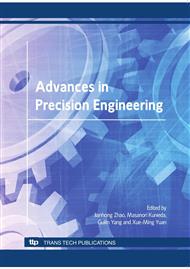[1]
W.K. Chen, T. Kuriyagawa, H. Huang and N. Yosihara: Prec. Eng. Vol. 29 (2005), p.315.
Google Scholar
[2]
T. Masuzawa and H.K. Tőnshoff: Annals of CIRP Vol. 46 (1997), p.621.
Google Scholar
[3]
H. Huang, W.K. Chen and T. Kuriyagawa: Int. Journal of Machine Tools and Manufacture, Vol. 47 (2007), p.2237.
Google Scholar
[4]
L. Yin, E.Y.J. Vancoille, K. Ramesh and H. Huang: Int. Journal of Machine Tools and Manufacture, Vol. 44 (2004), p.607.
Google Scholar
[5]
L. Yin, A.C. Spowage, K. Ramesh, H. Huang, J.P. Pickering and E.Y.J. Vancoille: Int. Journal of Machine Tools and Manufacture Vol. 44 (2004), p.533.
DOI: 10.1016/j.ijmachtools.2003.10.022
Google Scholar
[6]
H. Huang, Y.Q. Wu, S.L. Wang, Y.H. He, J. Zou, B.Y. Huang and C.T. Liu: Materials Science and Engineering A Vol. 523 (2009), p.193.
Google Scholar
[7]
H. Huang, K. Winchester, A. Suvorova, B.R. Lawn, Y. Liu, X.Z. Hu, J.M. Dell and L. Faraone: Materials Science and Engineering A Vol. 435-436 (2006), p.453.
DOI: 10.1016/j.msea.2006.07.015
Google Scholar
[8]
H. Huang, K. Winchester, Y. Liu, X.Z. Hu, C.A. Musca, J.M. Dell and L. Faraone: Journal of Micromechanics and Microengineering Vol. 15 (2005), p.608.
Google Scholar
[9]
T. Schoberl, H.S. Gupta and P. Fratzl: Materials Science and Eng. A Vol. 363 (2003), p.211.
Google Scholar
[10]
H. Huang, R. Irwan and T. Kuriyagawa: Key Eng. Mater. Vol. 329 (2007), p.385.
Google Scholar
[11]
R. Irwan and H. Huang: Int. Jour. of Surface Sci. and Eng. Vol. 2 (2008) p.29.
Google Scholar
[12]
I. Zarudi, L.C. Zhang and D. Cockayne: Jour. of Mater. Sci. Vol. 33 (1998), p.1639.
Google Scholar
[13]
H.K.K. Xu and S. Jahanmir: Journal of American Ceramic Society Vol. 77 (1994), p.1388.
Google Scholar
[14]
G. Subash and R. Bandyo: Journal of American Ceramic Society Vol. 88 (2005), p.918.
Google Scholar
[15]
B.D. Beake and N. Ranganathan: Materials Science and Eng. A Vol. 423 (2006), p.46.
Google Scholar
[16]
N. Tayebi, T.F. Conry and A.A. Polycarpou: Journal of Mater. Res. Vol. 18 (2003), p.2150.
Google Scholar
[17]
H.Q. Sun, R. Irwan, H. Huang and G.W. Stachowiak: Adv. Mater. Res. Vol. 76 (2009), p.609.
Google Scholar
[18]
H.Q. Sun, R. Irwan, H. Huang and G.W. Stachowiak: Wear, 10. 1016/j. wear. 2010. 02. 014.
Google Scholar
[19]
G.S. Upadhyaya: Cemented Tungsten Carbides: Production, Properties and Testing (Culinary and Hospitality Industry Publication Service, Texas 2005).
Google Scholar
[20]
N.I. Tymiak, A. Daugela, T.J. Wyrobrek and O.L. Warren: Journal of Mater. Res. Vol. 18 (2003), p.784.
Google Scholar


